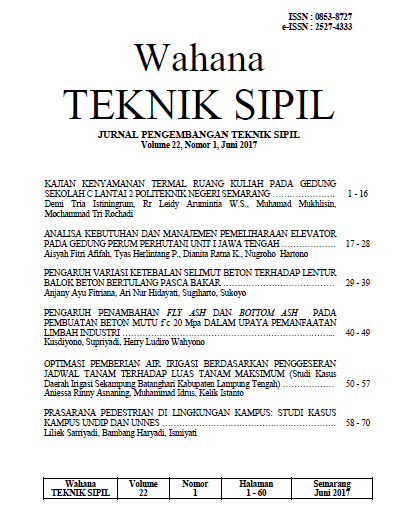Pengaruh Variasi Ketebalan Selimut Beton Terhadap Lentur Balok Beton Bertulang Pasca Bakar
DOI:
https://doi.org/10.32497/wahanats.v22i1.897Abstract
High temperatures at the time of the fire have a considerable influence on the residual strength of existing concrete. So that it would also result in the use of the building after the fire. The purpose of the study was to assess the extent of the percentage reduction in the compressive strength and flexural strength in the postcombustion reinforced concrete beams with concrete cover thickness and combustion with different duration. The research method by giving a different duration of combustion in 6 hours and 8 hours to beam test specimen measuring 150 mm x 200 mm x 600 mm with a thick concrete cover of 2 cm, 3 cm, 4 cm and 5 cm with the quality of concrete fc' 22,5 MPa the test beam to the age of 28 days. The result taken from the test will be displayed in a graph of the relations between the length of the combustion duration and a decrease in flexural strength that occurs in any concrete covers. The result is the percentage decrease in the flexural strength smaller as thick blankets. The test results showed that the percentage decrease in the covers 2 cm on burning six hours by 19.72 % and 30.25 % in burning 8 hours. At 3 cm thick blanket large consecutive decrease 10.72 % at 6 hours and burning of 23.58 % on burning eight hours. At 4 cm thick blanket was 6.63% on combustion 6 hours , and 22.09 % on burning eight hours. While on the covers 5 cm was 5.97% at 6 hours and burning of 21.64 % on burning 8 hours. While the compressive strength after burning 6 hours is 19.26 MPa with decreased 15.44 % , and the compressive strength in the burning of 8 hours is 17.74 MPa to 22.11 % decline from the beginning without burning compressive strength of 22.78 MPa
Kata kunci : flexural strength, concrete cover, after fire concrete, concrete beams
Downloads
Published
Issue
Section
License
Authors who publish with this journal agree to the following terms:Authors retain copyright and grant the journal right of first publication with the work simultaneously licensed under a Creative Commons Attribution License that allows others to share the work with an acknowledgement of the work's authorship and initial publication in this journal.
Authors are able to enter into separate, additional contractual arrangements for the non-exclusive distribution of the journal's published version of the work (e.g., post it to an institutional repository or publish it in a book), with an acknowledgement of its initial publication in this journal.
Authors are permitted and encouraged to post their work online (e.g., in institutional repositories or on their website) prior to and during the submission process, as it can lead to productive exchanges, as well as earlier and greater citation of published work (See The Effect of Open Access).






